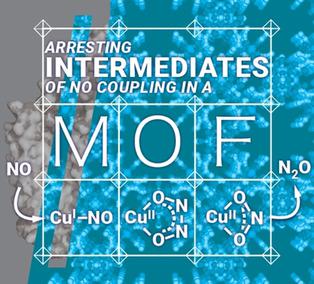当前位置:
X-MOL 学术
›
Angew. Chem. Int. Ed.
›
论文详情
Our official English website, www.x-mol.net, welcomes your
feedback! (Note: you will need to create a separate account there.)
Spectroscopic Evidence of Hyponitrite Radical Intermediate in NO Disproportionation at a MOF‐Supported Mononuclear Copper Site
Angewandte Chemie International Edition ( IF 16.1 ) Pub Date : 2021-03-01 , DOI: 10.1002/anie.202015359 Chenyue Sun 1 , Luming Yang 1 , Manuel A. Ortuño 2 , Ashley M. Wright 1 , Tianyang Chen 1 , Ashley R. Head 3 , Núria López 2 , Mircea Dincă 1
Angewandte Chemie International Edition ( IF 16.1 ) Pub Date : 2021-03-01 , DOI: 10.1002/anie.202015359 Chenyue Sun 1 , Luming Yang 1 , Manuel A. Ortuño 2 , Ashley M. Wright 1 , Tianyang Chen 1 , Ashley R. Head 3 , Núria López 2 , Mircea Dincă 1
Affiliation

|
Dianionic hyponitrite (N2O22−) is often proposed, based on model complexes, as the key intermediate in reductive coupling of nitric oxide to nitrous oxide at the bimetallic active sites of heme‐copper oxidases and nitric oxide reductases. In this work, we examine the gas‐solid reaction of nitric oxide with the metal–organic framework CuI‐ZrTpmC* with a suite of in situ spectroscopies and density functional theory simulations, and identify an unusual chelating N2O2.− intermediate. These results highlight the advantage provided by site‐isolation in metal–organic frameworks (MOFs) for studying important reaction intermediates, and provide a mechanistic scenario compatible with the proposed one‐electron couple in these enzymes.
中文翻译:

MOF支持的单核铜位点中NO歧化过程中亚硝酸根的中间体的光谱证据
在模型络合物的基础上,通常建议使用二价次氮亚硝酸盐(N 2 O 2 2-)作为血红素铜氧化酶和一氧化氮还原酶双金属活性位上一氧化氮与一氧化二氮还原偶联的关键中间体。在这项工作中,我们通过一整套原位光谱学和密度泛函理论模拟,研究了一氧化氮与金属-有机骨架Cu I -ZrTpmC *的气固反应,并确定了一种异常的螯合N 2 O 2 .-中间的。这些结果凸显了金属有机框架(MOF)中位点分离提供的用于研究重要反应中间体的优势,并提供了与这些酶中建议的单电子对兼容的机理。
更新日期:2021-03-23
中文翻译:

MOF支持的单核铜位点中NO歧化过程中亚硝酸根的中间体的光谱证据
在模型络合物的基础上,通常建议使用二价次氮亚硝酸盐(N 2 O 2 2-)作为血红素铜氧化酶和一氧化氮还原酶双金属活性位上一氧化氮与一氧化二氮还原偶联的关键中间体。在这项工作中,我们通过一整套原位光谱学和密度泛函理论模拟,研究了一氧化氮与金属-有机骨架Cu I -ZrTpmC *的气固反应,并确定了一种异常的螯合N 2 O 2 .-中间的。这些结果凸显了金属有机框架(MOF)中位点分离提供的用于研究重要反应中间体的优势,并提供了与这些酶中建议的单电子对兼容的机理。

































 京公网安备 11010802027423号
京公网安备 11010802027423号